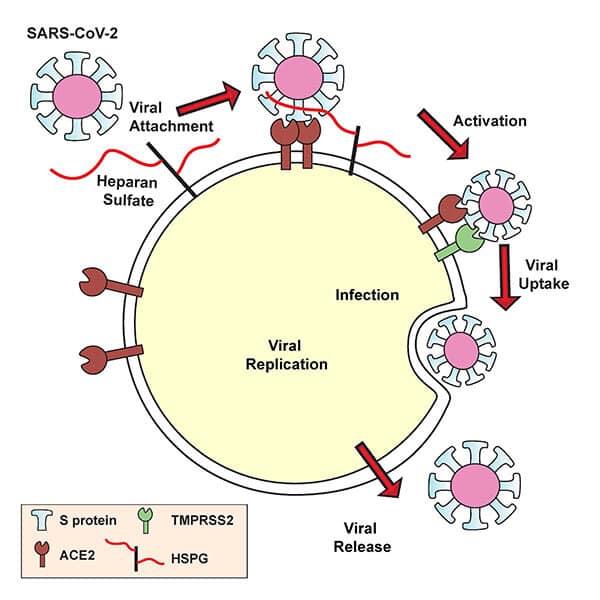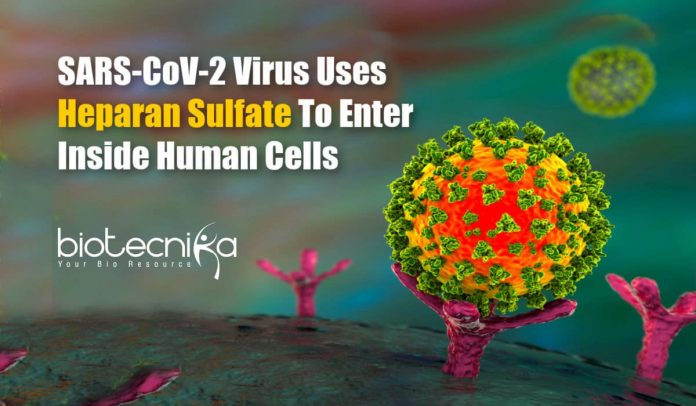SARS-CoV-2 Uses Heparan Sulfate & ACE2 For Entering Inside Cells
On the outer surfaces of the cells that line the lungs, the ACE2 molecule sits like a doorknob. Researchers have known since January 2020 that the COVID-19 causing novel coronavirus, SARS-CoV-2 virus establishes respiratory infections in humans particularly using ACE2 to enter the human cells. The goal of many research studies to treat the infection has become to find a way to block the interaction between viruses and the ACE2 protein.
Now, researchers from the University of California San Diego School of Medicine have discovered that a carbohydrate acts as a co-receptor for viral entry, and without this carbohydrate called heparan sulfate, which is also found on lung cell surfaces, the SARS-CoV-2 virus will not be able to grab onto ACE2.
The co-director of the Glycobiology Research and Training Center at UC San Diego and Distinguished Professor of Cellular and Molecular Medicine at UC San Diego School of Medicine, Jeffrey Esko, Ph.D. said, “ACE2 isn’t the whole picture, it is only part of the story.” A potential new approach for preventing and treating COVID-19 is introduced in Esko’s study, published in the journal Cell.
Two approaches that can reduce the ability
of SARS-CoV-2 to infect human cells cultured in the lab by approximately 80-90% were demonstrated by the research team: The first approach is to use enzymes for removing heparan sulfate. The second approach is to lure and bind the coronavirus away from human cells by using heparin as bait. Using heparin suggests that a Food and Drug Administration-approved drug could be repurposed to reduce virus infection as heparin, a form of heparan sulfate, is already a widely used medication to prevent and treat blood clots.
Heparan sulfate and the role it plays in disease and health have been studied by Esko’s team for a long time. Along with postdoctoral researcher Daniel Sandoval, Ph.D., and visiting scholar Thomas Mandel Clausen, Ph.D., he led this study.
Clausen said that in March 2020, he came across a preliminary study that suggested an interaction between the coronavirus’s spike protein and that the virus uses another carbohydrate related to heparan sulfate to grab the ACE2 molecule.
After this, the team started to test their theories in the laboratory. They discovered that the SARS-CoV-2 spike protein binds to heparin and also drilled down to uncover the SARS-CoV-2 spike protein’s exact part that interacts with the receptor-binding domain— heparin. The binding to ACE2 is increased and the receptor-binding domain opens up when heparin is bound. They found that for the virus to get inside human lung cells grown in a laboratory dish, the virus must bind both heparan sulfate on the cell surface and ACE2.
Next, the researchers set about trying to disrupt it, after this viral entry mechanism was established. They found that the SARS-CoV-2 is prevented from gaining entry into cells by enzymes that remove heparan sulfate from cell surfaces. Similarly, the infection was blocked by treatment with heparin. The heparin treatment worked as an anti-viral at doses currently given to patients, even when the part that is responsible for preventing blood clots— the anticoagulant region of the protein were removed by the researchers.
Esko said that for the findings to translate into a COVID-19 treatment for people, there is more research needed. Researchers will need to use animal models of SARS-CoV-2 infection and test heparin and heparan sulfate inhibitors.
Additionally, the role the bacteria that live in and on the body— the human microbiomes, in influencing a person’s susceptibility to COVID-19 by altering heparan sulfate, are being explored by the UC San Diego scientists in a related study.
Source
SARS-CoV-2 Uses Heparan Sulfate & ACE2 For Entering Inside Cells






























